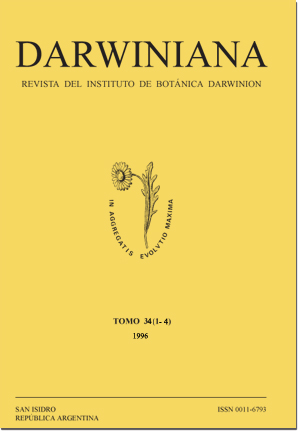Morphology of inflorescences in Verbenaceae-Verbenoideae. I: Tribe Verbeneae.
DOI:
https://doi.org/10.14522/darwiniana.2014.341-4.383Abstract
This paper deals with the interpretation, description and typological characterization of the inflorescences of the genera belonging to the tribe Verbeneae. These genera are: Glandularia Gmelin, Hierobotana Briquet, Junellia Moldenke, Tamonea Aublet, Verbena Linné and Urbania R. A.Philippi, all of them represented in South America. All the cases belong to the polytelic type of synflorescences. Florescences of almost all genera are dense spikes with decussate bracts. Only Tamonea has loose, spiciform racemes with disperse bracts. Floral prophylls are always absent. The heterothetic pleiobotryum is the most frequent branching form, present in Verbena, Glandularia and Hierobotana. Urbania and Junellia have monobotrya. Homothetic pleiobotrya characterize all species of Tamonea. Heteroblastic development of the branches can be observed in several species of Junellia. In these cases flowering can be restricted to the brachyblasts, a frequent specialization in woody plants. The heterothetic paniculiform pleiobotryum has been mentioned for several families of the Angiospermae as a primitive or central form, from which other forms derived through processes such as condensation, reduction and truncation. In Verbeneae this non specialized "paniculodium" is present in Verbena and Glandularia. Condensation of the florescences, to compose more or less functionally discrete subunits, appears in Verbena ser. Pachystachyae and Glandularia subgen. Paraglandularia.Reduction of the enriching zone occurs in Urbania and most Junellia species. Such reduction and decrease of flower number in the florescences could be related to the xerophyllous nature of these species. Truncation of the main florescence, such as the homogenization and racemization of the distal paracladia, have been produced in Tamonea giving rise to an homothetic pleioraceme. Tamonea shows few affinities with the remaining genera of Verbeneae. It differs from them in several inflorescence characters and gynoecial features previously studied by other authors. Because of all these characters, the place of this genus within the Verbenoideae should be reconsidered.Downloads
Published
31-12-2011
How to Cite
Martínez, S., Botta, S., & Múlgura, M. E. (2011). Morphology of inflorescences in Verbenaceae-Verbenoideae. I: Tribe Verbeneae. Darwiniana, Nueva Serie, 34(1-4), 1–17. https://doi.org/10.14522/darwiniana.2014.341-4.383
Issue
Section
Anatomy and Morphology
License

Starting on 2012, Darwiniana Nueva Serie uses Licencia Creative Commons Atribución-NoComercial 2.5 Argentina .






